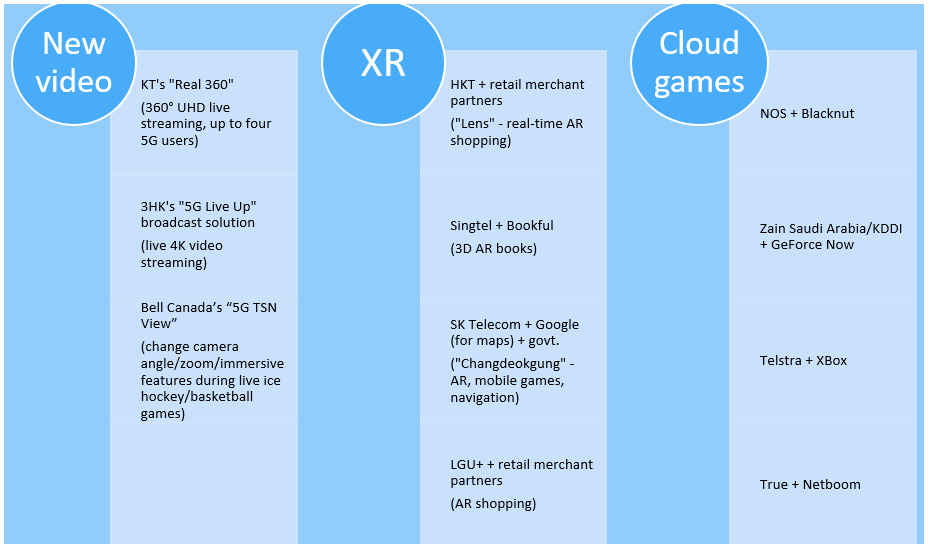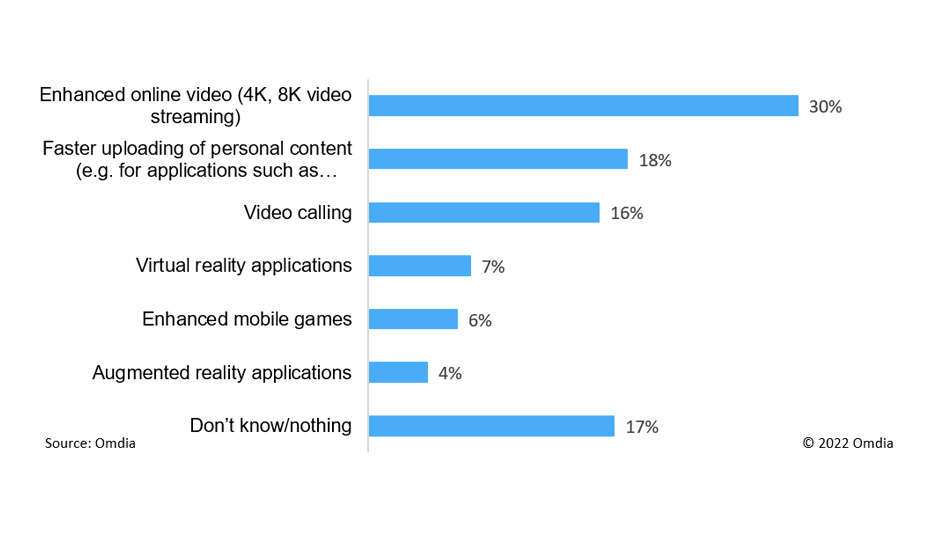
WinWin Issue 42
Tao of Business
Senior Principal Analyst, 5G & Broadband Pricing and Strategy, Omdia
5G Apps Thrive – 40% of Telcos Launch Enhanced Apps for Consumers
-- As 5G networks develop and grow in popularity, the number of 5G subscribers surges, providing a key basis for 5G service innovation. In the consumer market, we are noticing diverse 5G applications based on 5G network capabilities in various forms and scenarios, such as new video, XR, and cloud games. Omdia research identifies the typical 5G rich app cases launched by global 5G telcos, and explores how to monetize 5G apps that leverage 5G network capabilities.
The enhanced mobile apps market continues to gain momentum as telcos leverage faster 5G network speeds and lower latency. New Omdia research found that 71 (or 37%) of 5G telcos have launched at least one 5G rich app; either enhanced video, mobile games, Augmented Reality (AR), or Virtual Reality (VR). That is impressive, given the consumer 5G market is only 3.5 years mature.
For those that have launched 5G rich apps, the app ecosystem is thriving (see figure 1), with an increasing amount of innovation around video, 4K video apps, XR, and cloud gaming. New video options facilitate 360° UHD live streaming, such as KT's Real 360 video chat service, which requires a Fitt360 wearable terminal that can be worn around the neck. Bell Canada's 5G TSN View enables sports users to change camera angles, zoom in, and enjoy immersive highlights during the streaming of live games — with no headset required. Meanwhile, 3HK's 5G Live Up broadcast solution enables real-time 4K streaming on the uplink and caters to User-Generated Content (UGC) video. The offer includes 100GB of 5G data (about 30 hours of live broadcasting) and 300 viewing hours (thereafter, it's HK$2/hour/person). The solution includes online ticketing so the content creator has a way of generating subscription video revenues. The one-time payment for the encoder, which enables streaming management, is HK$1,200 (US$153).
Meanwhile, AR apps encompass real-time shopping in the case of HKT's Lens app and 3D AR children's e-books. SKT has developed an AR app focused around Changdeokgung, a popular tourist destination in South Korea, that leverages edge networking capabilities for AR navigation and location-specific cloud games. Moreover, by enabling technologies such as AR and VR, 5G has opened new models, with not every monetization route being direct-to-consumer. Rather, as shown in figure 1, telcos can also monetize apps through merchant commissions from retailers.
Figure 1: 5G facilitates live 4K streaming, AR and cloud games

Source: Omdia
It is not just China, Korea, and Japan that are leading 5G rich app development and collaboration; launches are reflective of other regions, including Europe, Latin America, the Middle East, and North America. Moreover, app bundling innovation is not restricted to developed markets, but is also relevant to emerging markets, like Thailand.
Bundling of 5G rich apps is commonplace, with telcos in the US and Asia reserving premium apps for those on the most expensive 5G plans, thereby driving upsell. Also, telcos in Hong Kong and Thailand — and a host of other markets — attempt to charge a subscription fee for premium apps. Cooperation on content with partners takes many different forms; white labeling or a wholesale content partnership are the most common as most telcos do not organically develop 5G applications from an incubation stage.
4K video streaming voted the most popular 5G app
Omdia's Digital Consumer Insights 2022 survey found that 4K video apps remain the application consumers are most interested in using on 5G, as shown in figure 2. Faster content uploads scored 18% in the poll. Meanwhile, consumer interest in VR and AR apps stood at a combined 11% in the survey. In a separate question, 28% of respondents said they would be interested in accessing AR/VR apps as part of a mobile or broadband service.

Notes: n=12,178
Source: Digital Consumer Insights 2022: 5G, Broadband and Bundling
In a separate survey, telcos agree with consumers — online video is a key driver of consumers to 5G. Advanced messaging, video calling, and cloud gaming were also considered key 5G drivers. At the end of 3Q22, there were 637 5G plans that included at least one 5G rich app. More than half of the plans (57%) led with a bundled 4K video app, followed by 27% with cloud games as the lead app. VR/AR apps were the main app in 13% of plans, with the metaverse taking 3%.
Telcos don't need to reinvent the wheel, but partner, partner, partner
The basic notion of 5G is that it offers something more compared to 4G, and that additional value warrants a moderate premium from consumers. In contrast, one of 4G's main marketed benefits was that it enabled 'video to be watched on a train' — hardly enough to justify paying more for over 3G. The evolution to 5G, however, enables more network capacity, a big speed jump — 300Mbps to up to 2Gbps, currently — and with edge network capabilities meaning lower latency.
In terms of monetization, operators with 5G network coverage that reaches beyond just hotspot areas are able to:
– Upsell consumers based on speed
– Upsell consumers based on the improved performance of 5G rich apps
– Upsell consumers based on larger data allowances
Upselling consumers from 4G is exactly what most telcos are doing. We asked operators about consumer 5G price plan premiums — some 59% of telcos said they charged a premium over 4G, although overall Average Revenue Per User (ARPU) in some markets remains challenged due to price competition.
For some, the new 5G ecosystem can be challenging to navigate. But getting apps to market is a joint effort, where insight from ecosystem partners is crucial. Whilst telcos have not been very good at sharing intelligence with each other, as far as apps go, this is changing with global content alliances and Tier 1 telcos showing increasing willingness to export apps to other operators in overseas markets.
Hand in hand with app innovation, is pricing model innovation. We are seeing more telcos offering a range of business models to consumers, from subscription apps to free teaser apps designed to entice consumers onto the 5G network. But more innovation is needed as operators upgrade to next-gen networks and future business models will need to evolve beyond just "the consumer pays". With network slicing, for example, new pricing models will need to evolve where the employer or even developer pays the telco.
Last, but very important to consumer monetization upselling, are devices. Here we are not talking about smartphones per se, but wearables (such as XR glasses) that will truly propel the performance and experience of next-gen apps to the next level. In short, the goal is for everyday objects to become increasingly connected, and wearable devices to become smaller and lighter. In Korea, Nreal's smart AR glasses are already available, and Mojo has developed lenses that sit on the white of the eye for AR. Verizon, Motorola, and Lenovo also recently agreed to partner on a hands-free wearable neckband, designed to hold the computing power so that glasses can become smaller. Next-gen wearables need not only to be practical and lightweight, but also affordable. To meet the affordability goal, operators will need to further innovate around device payment options for consumers.


